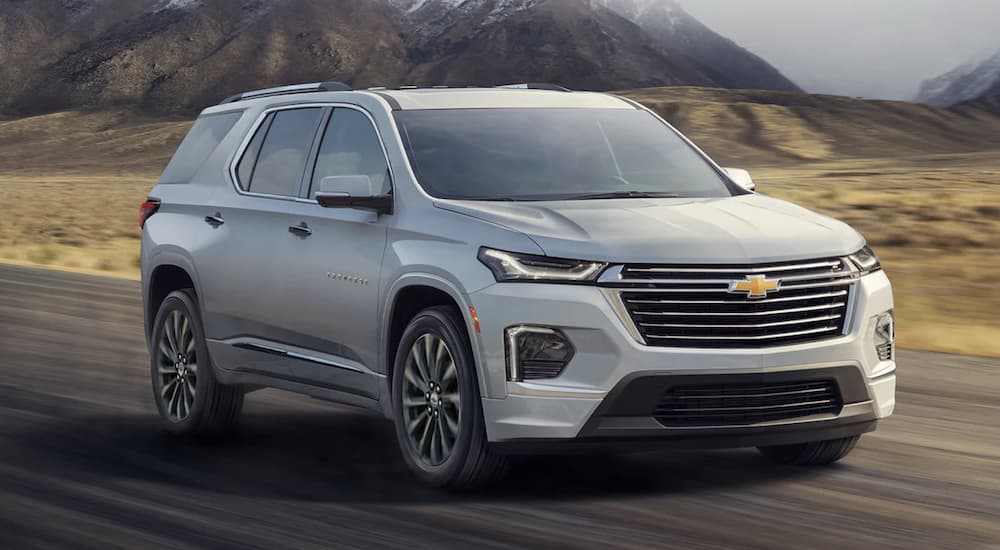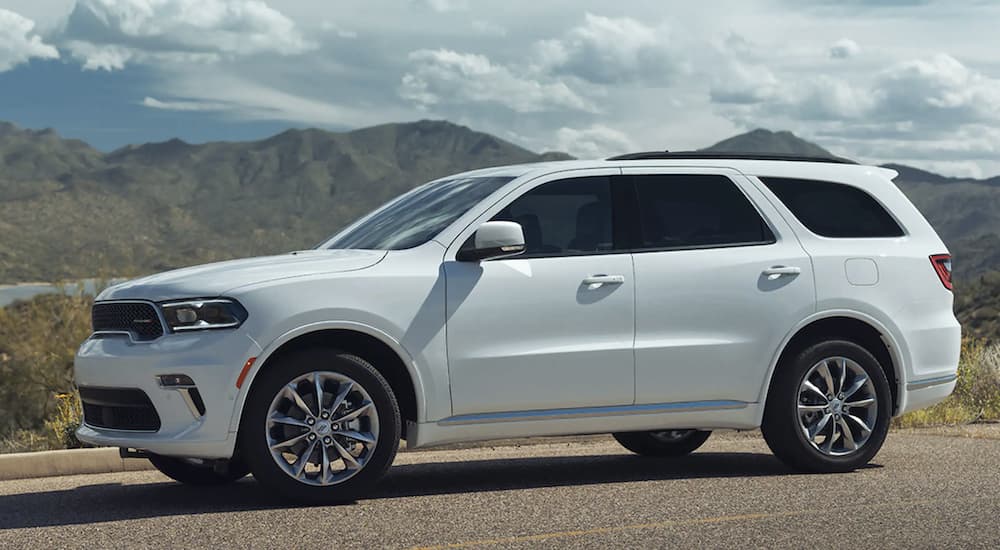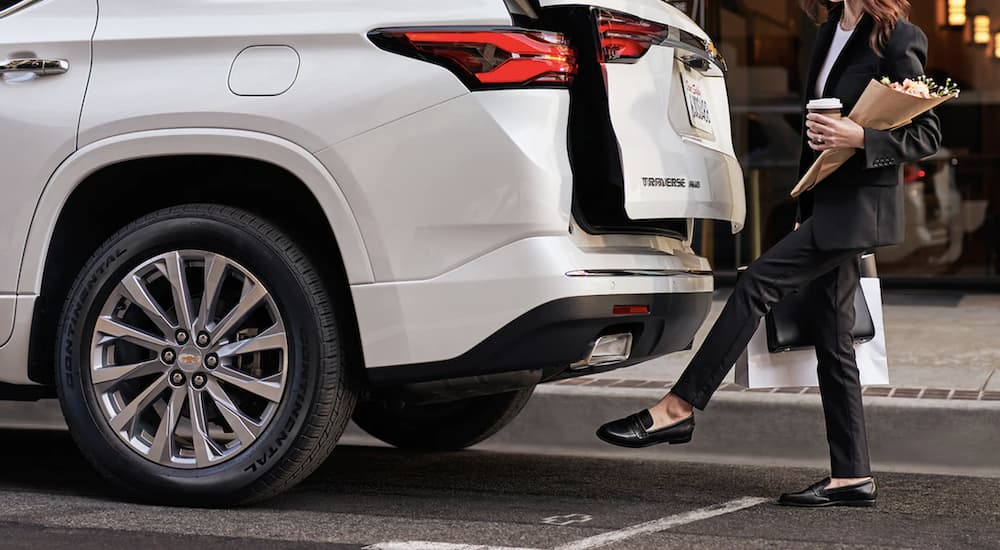Midsize SUVs are a unique breed of vehicles due to where they fit in the marketplace segment. They’re larger than the average two-row midsize SUV but not quite large enough to be considered a full-on, full-size SUV. These unique unicorns make for interesting prospects for some drivers because of where they’re positioned in the market. Usually, they also have a cost just above most midsize SUVs but not as expensive as full-size luxury SUVs.
But what’s the real hook for going with a midsize three-row SUV? Well, one of the big selling points is space. There’s simply more room to work with in a midsize three-row than in a standard compact or midsize SUV. It also makes for an interesting comparison between other midsize SUVs in the segment when it comes to better understanding which ones offer you the most room without being classified as a full-size SUV. That’s what this article here attempts to examine between the 2022 Chevy Traverse vs 2022 Dodge Durango. Which one offers the most space, and how is that space utilized?
Three Rows Don’t Guarantee Equal Seating
We’ve been seeing various midsize SUVs dabble in three-row seating for a while. Maybe you can’t afford the upper-end full-size vehicles, but you still need to sit seven or eight people in a vehicle? Well, that’s where midsize three-rows come into play. Both the 2022 Chevy Traverse and 2022 Dodge Durango fit the bill of being midsize SUVs with third-row seating. However, they both aren’t the same size.
The three-row seating accommodations in the Dodge Durango and Chevy Traverse are both unique and interesting in their own rights, but the Durango gives up some space for configurable seating options. In fact, it has more than 50 different seating configurations. This is because the Durango has two sets of captain chairs and a third 60/40 split-bench for the third row. Both the second and third rows of the Durango can also be folded up or removed to make more room for cargo. However, all of those configurations come at the expense of seating an extra person, which is why the 2022 Durango can only seat up to seven people instead of eight.
The 2022 Chevy Traverse, meanwhile, opts for three-row seating where there are two captain chairs and two 60/40 split-benches. This frees up more room for an extra person on each bench, as opposed to having four people across two rows; you can fit five people across two rows and then three more in the very back. For the Traverse, the second-row passenger-side seat features what’s called a SmartSlide, so you can quickly slide the seat around in order to get to the third row.
However, for those of you thinking, “Well, at least the Durango has two sets of captain chairs!” there’s something else to consider: the Traverse can be configured the same as the Durango. Certain trims are available in what’s called a 2-3-3 configuration for two captain chairs in the front and two bench seats in the second and third row, as well as a 2-2-3 configuration, which consists of four captain chairs across the first two rows, and a 60/40 split-bench for the third row. So even while the Durango may have 50+ different configurations available for the seven-passenger seating and standard sets of four captain chairs in total, the Traverse also allows for the same set of captain chairs.
In fact, for the RS, Premier, and High Country trims, the Traverse comes standard with seven-passenger seating. This means that if you want the luxury options of the second row, fold-flat captain chairs, you can indulge in said option with the Traverse.
Competing for Passenger Volume
Having more seats doesn’t always equate to more interior room. There are some cases where some nameplates will throw in as many seats as possible while restricting passenger volume to an absurd degree. Luckily, in the case of the 2022 Chevy Traverse vs 2022 Dodge Durango debate over capacity, neither sacrifices much in the region of passenger volume to accommodate passengers. However, what is interesting is how the Traverse actually offers more passenger volume than the Durango, even with the extra seating capacity.
The Durango’s passenger volume tops out at 141 cubic feet, whereas the Traverse’s passenger volume clocks in at 157.1 cubic feet of space. That’s approximately 10% more passenger volume in the Traverse than the Durango. This translates into a couple of more inches across the total movable space within the Traverse. For instance, in the Traverse, you have 1.1 inches of additional hip room in the first row, 1.4 inches of extra hip room in the second row, and a massive 6.1 inches of additional hip room in the third row compared to the Durango.
You also see similar differences in volume with dimensions like shoulder space, where you get 3.4 inches of extra shoulder room in the Traverse’s front row, 4.5 inches of additional shoulder room in the second row, and a total of 7.1 inches of additional shoulder room in the third row. So there’s a scale of differences in total passenger volume between the two vehicles, especially where it counts with not feeling totally crammed in the second and third rows.
The Value of Cargo Volume
When it comes to interior cabin space with midsize three-rows, the inclusion of a third row often comes at the expense of cargo volume. It’s just the way the dice fall most times. You have a limited resource budget when it comes to cabin space, and you can either prioritize passenger volume (and comfort) or cargo volume. Striking that fine balance between the two can be a real challenge.
Between the 2022 Chevy Traverse vs 2022 Dodge Durango, we can see how the extra dimensions of the Traverse afford for more passenger volume, but can the same be said of cargo volume? For those of you wondering what the difference is between the two, with passenger volume, you’re counting the occupied space from where your feet touch the floor all the way to the crown of your head––all of the space within those dimensions is movable and can be occupied by people sitting upright. With cargo, it’s a bit different. Most times, you’re relying on stackable items or materials that will lay or fit flat in the storage areas. So the most important part of the cargo area is whatever flat surfaces you have available for storage.
With the Durango’s seating arrangements and dimensions, you can see how it affects the available cargo space. Interestingly enough, the Durango’s wheelbase is only 1.1 inches shorter than the Traverse and only 2.8 inches thinner, yet it makes a fairly significant difference in how the space within the cabin is utilized based on the frame. For instance, the Durango’s rear cargo volume behind the third row only affords 17.2 cubic feet of usable space, compared to the 23 cubic feet of space behind the third row of the Traverse. The numbers only move more in favor of the Traverse the more you consider how much volume you get in the first and second row, especially with the second row folded. For instance, in total, the Durango has up to 85.1 cubic feet of cargo volume compared to the Traverse’s 98.2 cubic feet of cargo volume.
A Little Bit of Room Can Make a Big Difference
In short, if you were planning on using the Traverse for storing, carrying, or hauling lots of items, you get plenty of space out of it, whether you make use of all three rows or not. Yes, you get more towing capacity out of the Durango, no doubt, but as far as interior volume is concerned, the Traverse has a nice little bow in that department, especially when you consider the passenger volume. How important that is to those of you who prefer midsize three-row SUVs with third-row seating is left up for you to decide.






